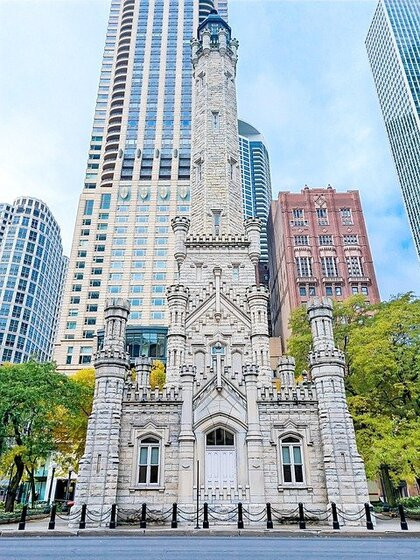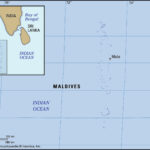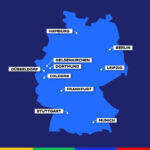Chicago, the Windy City, is a sprawling metropolis that hugs the shores of Lake Michigan, a dazzling display of steel and glass that firmly holds its place as the heart of the Midwest. But beyond the impressive skyline lies a city brimming with cultural experiences as diverse as America itself, catering to every taste imaginable. Choosing the right neighborhood to stay in can significantly enhance your visit, allowing you to immerse yourself in the city’s unique atmosphere and easily access the attractions that interest you most.
This guide will navigate you through Chicago’s most popular neighborhoods, providing insights and recommendations to help you pinpoint the perfect base for your Chicago adventure. From world-class museums and architectural marvels to vibrant nightlife and serene parks, Chicago’s neighborhoods offer something for everyone.
 Chicago Neighborhood MapDetailed map of Chicago neighborhoods for tourists, highlighting key districts like The Loop, Near North, and more
Chicago Neighborhood MapDetailed map of Chicago neighborhoods for tourists, highlighting key districts like The Loop, Near North, and more
Chicago is a city of distinct districts. The central neighborhoods, branching out from Downtown, are home to many of the iconic landmarks visitors flock to see: museums, galleries, beaches, parks, towering skyscrapers, and premier shopping destinations. The North Side pulses with theaters, lively bars, and energetic clubs. The South Side offers beautiful beaches, authentic soul food, the cultural enclave of Chinatown, and fascinating museums. Meanwhile, the West Side exudes a trendy, urban grit. Getting around is relatively straightforward; the city’s grid system is easy to navigate, and public transportation is both affordable and efficient. Chicago’s train system, affectionately known as the “L” (for “elevated”), and bus network make exploring simple. The heart of Chicago is also incredibly pedestrian-friendly, encouraging you to discover its charm on foot.
Downtown Chicago and The Loop
 The iconic Cloud Gate sculpture ("The Bean") in Millennium Park, located in The Loop, Chicago
The iconic Cloud Gate sculpture ("The Bean") in Millennium Park, located in The Loop, Chicago
The Chicago Bean and skyline in The Loop, a central district known for skyscrapers and attractions
“The Loop,” a name derived from the elevated train tracks encircling Chicago’s central business district, is the bustling heart of Downtown Chicago. Bordered by Lake Michigan to the east and the Chicago River to the north and west, The Loop is where Chicago’s most famous skyscrapers pierce the sky, including Willis Tower (formerly Sears Tower) and the Chicago Board of Trade. This neighborhood is an architectural showcase, boasting some of the city’s most iconic buildings.
Beyond the skyscrapers, The Loop is a cultural powerhouse. It’s home to the Theater District, the renowned Art Institute of Chicago, the fascinating Money Museum, and Millennium Park, which features architectural gems like the Pritzker Pavilion and the mesmerizing Cloud Gate (“The Bean”). The Loop is also a treasure trove of public art, showcasing sculptures from some of the 20th century’s most influential artists. As Chicago’s central transportation hub, all “L” train lines converge here, along with numerous bus routes, making it incredibly accessible.
While the Magnificent Mile, Chicago’s premier shopping street, begins just north of the Chicago River in Near North, The Loop still offers a mix of familiar brands and unique stores, including the expansive Jeweler’s Center. Dining options are plentiful in The Loop, particularly during the day, catering to the workday crowd. You’ll find clusters of cafes and restaurants near major tourist attractions, though exploring a bit further afield can lead to more authentic and less tourist-centric dining experiences.
Pros and Cons of Staying in The Loop
- Pros: Iconic architecture, major tourist attractions, incredibly central location, stunning water views (Lake Michigan and Chicago River), world-class art galleries and museums.
- Cons: Primarily a business district, can feel less residential, potentially higher hotel prices.
- Ideal For: First-time visitors to Chicago, sightseeing enthusiasts, architecture and photography buffs, families, art and culture lovers.
Explore the Best Hotels in The Loop
The Near North Neighborhood
 Streeterville neighborhood in Near North, Chicago, featuring high-rise buildings and city views
Streeterville neighborhood in Near North, Chicago, featuring high-rise buildings and city views
Chicago’s Near North neighborhood, a mix of residential and commercial buildings near Lake Michigan
Just across the Chicago River from The Loop lies the Near North neighborhood, home to the Magnificent Mile, or Michigan Avenue. This is Chicago’s most glamorous thoroughfare, famed for its luxury boutiques, department stores, flagship stores of global brands, and upscale restaurants, bars, and cafes. The Near North encompasses several distinct areas: River North, known for its vibrant art gallery scene, trendy restaurants, bustling bars, and lively nightclubs; Streeterville, nestled between Lake Michigan and the Magnificent Mile; and the Gold Coast, an affluent residential area boasting grand historic hotels and some of Chicago’s most prestigious and expensive streets.
The Near North is a lively and upscale part of the city, buzzing with activity yet slightly less frenetic than The Loop. You can easily find respite from the energy by strolling along the Chicago River. A prominent landmark in Near North is the Chicago Water Tower, a survivor of the Great Chicago Fire of 1871. Other highlights include the Museum of Contemporary Art, The Arts Club of Chicago, and the numerous art galleries in River North. Navy Pier, offering 50 acres of entertainment and attractions, extends out into Lake Michigan from the Near North shoreline.
Pros and Cons of Staying in Near North
- Pros: Premier shopping destination (Magnificent Mile), numerous art galleries, central location, luxurious hotels and fine dining restaurants, vibrant nightlife, elegant atmosphere, beautiful water views.
- Cons: Can be an expensive area to stay, potentially crowded, especially along the Magnificent Mile.
- Ideal For: Serious shoppers, art enthusiasts, travelers seeking luxury and indulgence, nightlife seekers, couples, families looking for upscale amenities.
Find Recommended Hotels in Chicago’s Near North
Navy Pier
 Navy Pier in Chicago with the Ferris wheel and skyline views
Navy Pier in Chicago with the Ferris wheel and skyline views
Panoramic view of Navy Pier, a popular entertainment destination in Chicago
Extending half a mile into Lake Michigan from the Near North, Navy Pier is a dedicated entertainment district spanning 50 acres. Its iconic centerpiece is the towering Ferris wheel, offering breathtaking views of the city and lake. Navy Pier is packed with restaurants, bars, and cafes, an IMAX theater, amusement park rides, a funhouse maze, boat tours, the Chicago Children’s Museum, the Chicago Shakespeare Theater, and parks with fountains and performance spaces. Its location adjacent to Near North and Downtown Chicago provides easy access to other major attractions.
Pros and Cons of Staying Near Navy Pier
- Pros: Major attractions right on your doorstep, family-friendly entertainment, diverse dining and drinking options, wide range of entertainment choices, stunning water views and lakefront access.
- Cons: Can be very crowded, especially during peak season and weekends, potentially noisy.
- Ideal For: Families with children, travelers seeking fun and readily available entertainment, sightseeing focused trips.
Discover Hotels Near Navy Pier
Near West Neighborhood
 The vibrant Fulton Market District in Chicago's Near West neighborhood
The vibrant Fulton Market District in Chicago's Near West neighborhood
Street scene in Fulton Market District, Near West Chicago, known for dining and nightlife
Even if you don’t choose to stay in Chicago’s Near West, a visit to Little Italy and Greektown for a meal is highly recommended. For a truly exceptional dining experience, the West Loop is a culinary hotspot, boasting some of Chicago’s most acclaimed and upscale restaurants. The Near West also has a thriving art gallery and club scene. While the University of Illinois at Chicago’s expansion has altered some of the area’s original character, the United Center, home of the Chicago Bulls, remains a major attraction (don’t miss the Michael Jordan statue outside). A smaller, newer market has emerged, offering flea market finds and delicious Mexican food, partially replacing the former large street market.
Pros and Cons of Staying in Near West
- Pros: Excellent dining options, central location, lively atmosphere, thriving art gallery scene, up-and-coming and trendy.
- Cons: Some areas have lost their original charm due to development, can be less visually appealing in certain parts compared to lakefront neighborhoods.
- Ideal For: Foodies, travelers seeking good value, those interested in exploring diverse culinary scenes and emerging neighborhoods.
Explore Hotels in Chicago’s West Loop Area
South Side and Hyde Park
 The Museum of Science and Industry in Hyde Park, South Side Chicago
The Museum of Science and Industry in Hyde Park, South Side Chicago
Exterior view of the Museum of Science and Industry, a major attraction in Hyde Park, Chicago
The South Side encompasses a collection of diverse neighborhoods, all relatively central, offering a rich blend of literary and architectural history, vibrant bars and art galleries, jazz music, and green spaces. Hyde Park stands out for its literary and architectural significance, showcasing Victorian mansions, beautifully restored Prairie School architecture, and remarkable Frank Lloyd Wright designs. Famously hosting the Chicago World’s Fair, Hyde Park is home to the Museum of Science and Industry, a lasting legacy of the event. It’s also renowned for its impressive bookstores and boasts a high concentration of Nobel Prize winners per capita. Bridgeport-Chinatown offers a mix of lively bars, art galleries, and, of course, authentic Chinese cuisine. Historically, it has a strong Irish-American heritage and is home to the White Sox baseball team, with local legends of hauntings adding to its intrigue. Bronzeville is steeped in jazz and African American history, once a vibrant hub of culture where legends like Louis Armstrong and Count Basie performed at the Sunset Cafe. Numerous monuments and museums commemorate this rich heritage. Major attractions include Washington Park, the DuSable Museum of African American History, and the striking “Fountain of Time” sculpture.
Pros and Cons of Staying in South Side/Hyde Park
- Pros: Historically significant, relatively central location, excellent museums, impressive architecture, monuments and public art, ample green spaces and parks.
- Cons: Slightly further from the absolute city center compared to The Loop or Near North, some areas can feel less tourist-oriented.
- Ideal For: History buffs, sightseeing travelers interested in culture and architecture, jazz music fans, outdoor enthusiasts seeking parks and green spaces.
Discover Hotel Recommendations in Hyde Park
West Side and Wicker Park
 Wicker Park neighborhood in West Side Chicago, known for its trendy and artistic vibe
Wicker Park neighborhood in West Side Chicago, known for its trendy and artistic vibe
Colorful street art and buildings in Wicker Park, a vibrant neighborhood in Chicago
Chicago’s West Side neighborhoods have a unique history rooted in its immigrant past. German, Polish, Ukrainian, and Czech immigrants established breweries here, creating thriving and culturally rich communities. While the area has evolved, a European flavor still lingers, making it a haven for beer and coffee connoisseurs.
Wicker Park is a standout neighborhood on the West Side, known for its trendy and hip atmosphere. While its “cool” factor has become more mainstream, it still retains a vibrant energy and offers plenty of trendy bars, restaurants, and independent boutiques. Wicker Park is also well-connected to the rest of the city via the Blue “L” line. Pilsen is another West Side gem, boasting hip art galleries and fantastic Mexican food. Logan Square offers a more elegant and residential vibe.
Pros and Cons of Staying in West Side/Wicker Park
- Pros: Excellent cafes and live music venues, hip and trendy atmosphere, numerous art galleries and independent shops, good value for money compared to central neighborhoods.
- Cons: Can feel slightly “hipster” or overly trendy for some, located further from the main tourist attractions compared to downtown.
- Ideal For: Travelers seeking a cool and trendy experience, coffee and beer aficionados, value-conscious travelers, those interested in nightlife and live music.
Explore Hotels in Chicago’s West Side Neighborhoods
North Side, Lincoln Park and Lakeview
 Lincoln Park in North Side Chicago, featuring green spaces and lakefront views
Lincoln Park in North Side Chicago, featuring green spaces and lakefront views
Scenic view of Lincoln Park with Lake Michigan in the background, a family-friendly area in Chicago
Lincoln Park is a family-friendly neighborhood characterized by its proximity to extensive parkland and green spaces. It’s a popular residential area, close to Old Town with its theaters and literary history, and the Lincoln Park Zoo. The neighborhood features a well-maintained shopping street and even a beach along the lakefront. Lincoln Park is also home to several excellent museums. As you approach Old Town, you’ll encounter impressive historic homes and mansions, part of the area sometimes referred to as the Gold Coast, known for its upscale residences. Lakeview is known for its lively nightlife and Wrigleyville, home to Wrigley Field and the Chicago Cubs, making it a fantastic destination for those seeking entertainment and music venues. The North Side neighborhoods also offer architectural points of interest and a wide array of dining and drinking options, especially for late-night eats.
Pros and Cons of Staying in North Side/Lincoln Park/Lakeview
- Pros: Beautiful water views, historic charm, family-friendly atmosphere, unique museums, vibrant nightlife in Lakeview, impressive architecture, good shopping options, sports venues (Wrigley Field), live music venues.
- Cons: Located further north of the absolute city center, can feel less centrally located for first-time visitors focused solely on downtown attractions.
- Ideal For: Families, sports fans (especially Cubs fans), luxury travelers seeking residential charm, night owls and partygoers, outdoor enthusiasts enjoying parkland and lakefront.


